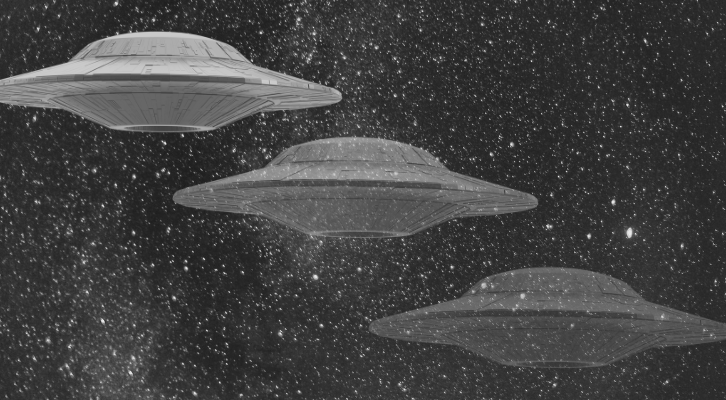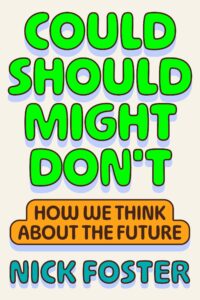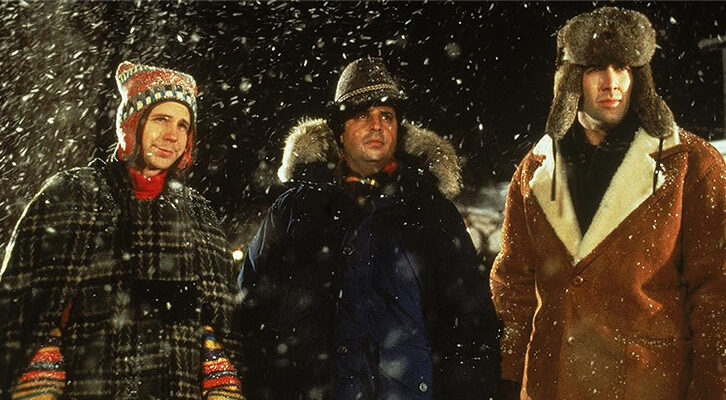
How to Think About the Future, With a Little Help From Science Fiction
Nick Foster Explores the Relationship Between Sci-Fi and Our Conception of the Future
In 1963, the esteemed author Arthur C. Clarke declared that “a critical reading of science fiction is essential training for anyone wishing to look more than ten years ahead.”
Well, I suppose he would, wouldn’t he?
It’s difficult to talk about Could Futurism without talking about science fiction, such is their intertwined and codependent nature. Many of the companies I’ve been a part of over the last twenty years gleefully embrace science fiction when describing the shape of the work they’re undertaking, the products they’re developing, or the intended outcomes they’re seeking, but what is science fiction exactly, and why does it hold such a powerful force over popular futurism?
We should probably begin by acknowledging that the term “science fiction” is something of an oxymoron: science is concerned with proof, facts, and testable, repeatable outcomes, whereas fiction is concerned with creativity, invention, and imagined situations. This is perhaps little more than a cute observation, but this oppositional duality is what can make science fiction incredibly interesting, engaging, and fun. It pokes at the status quo and imagines what else might happen, if only we could squeeze scientific truth into a new shape of our choosing.
Many literature critics turn their noses up at science fiction, often dismissing it as silly, niche, or escapist, but it remains wildly popular.
It’s actually quite difficult to cleanly define science fiction. It doesn’t fit into a neat thematic bucket, and its boundaries are notoriously ill-defined and fuzzy, mingling with fantasy, fairy tale, and horror, and overlapping a little with the worlds of wizards, orcs, and warlocks. It’s odd, for example, that we consider Luke Skywalker’s landspeeder to be a piece of science fiction but Aladdin’s flying carpet to be a work of fantasy. The two seem fairly similar, at least in principle.
We shouldn’t assume that science fiction is solely focused on the future either. Many key science fiction texts are set in alternate pasts, parallel versions of the present, or entirely nonterrestrial time frames. Regardless of this taxonomic uncertainty, science fiction literature has become incredibly popular, generating over half a billion dollars in revenue every year in the United States alone, and in some territories such as the UK, sales are growing significantly. In truth, these numbers are likely much higher, as science fiction has a vibrant culture of selfpublication, and operates far below the radar of traditional industry analysis. Many literature critics turn their noses up at science fiction, often dismissing it as silly, niche, or escapist, but it remains wildly popular. Frank Herbert’s 1965 science fiction epic, Dune, has sold in excess of 20 million copies, which is significantly more than Jane Austen’s enduring classic Pride and Prejudice.
Science fiction also plays a strong role in the much larger comic book industry, which now accounts for around $15.5 billion in yearly global sales. Both books and comics have played a major role in bringing science fiction to popular acclaim, but these industries pale into insignificance when compared with the most immersive, pervasive, and persuasive format of all: cinema.
It’s curious that one of the world’s earliest films—and certainly one of the earliest known moments of cinematic progress—is a work of science fiction. In 1902, George Méliès created Le voyage dans la lune (translated as A Trip to the Moon), a whimsical eighteen-minute adventure film that follows six members of a Parisian astronomy club on a mission to the lunar surface. The 1902 film may have no sound, but it’s a joyful creation—a fast-paced hybrid of animation and stage play, complete with painted sets, jump cuts, acrobatics, and elaborate costumes, which makes the whole thing feel utterly charming and dreamlike. After its premiere, the film became a huge success in France and around the world, running uninterrupted at the Olympia music hall in Paris for several months and becoming a headline attraction at theaters in Germany, Canada, and Italy. A Trip to the Moon was so popular in the United States that it was copied (in acts of willful piracy) by other experimental filmmakers, including Thomas Edison, much to the disapproval of Méliès.
In the early years of mass-consumption cinema, science fiction films were often considered niche productions, with cheaply produced sets, questionable prosthetics, and lowgrade special effects, but these B movies proved to be surprisingly popular with audiences. Pulpy titles such as The Phantom Creeps, Zombies of the Stratosphere, and Flying Disc Man from Mars featured at cinemas and drive-ins across America, and parallel sci-fi film industries quickly sprang up all across the globe. By the late 1950s, audiences were becoming more interested in scientific progress due to the post-war technology boom and the space race, resulting in a steady increase in the genre’s popularity and associated box-office success.
His simple tale of good versus evil set a long time ago in a galaxy far, far away proved to be hugely appealing to audiences desperate for some form of escape from the grim world outside.
In the 1960s, the genre became cemented in mass culture with the release of films including The Time Machine, Barbarella, and Stanley Kubrick’s masterpiece, 2001: A Space Odyssey, quashing the notion of science fiction as a specialist niche art form and thrusting it into the spotlight of mainstream appeal. In the 1970s, science fiction took a decidedly bleak turn in parallel with the changing shape of global politics and public opinion. As audiences wrestled with the very real specters of stagflation, the Cold War, Watergate, multiple energy crises, and countless global conflicts, science fiction broadly followed suit with movies such as The Omega Man, Westworld, and Soylent Green…until a weird little space picture took everyone by surprise.
On May 1, 1977, the first public screening of Star Wars: Episode IV—A New Hope took place at Northpoint Theatre in San Francisco. Initial responses to test screenings had been muted, and the movie wasn’t predicted to be much of a success. The board at Fox Studios weren’t convinced that a Buck Rogers–style science fiction movie would fill theaters, so they decided to restrict the film’s initial distribution in order to limit their losses. However, it quickly became clear that George Lucas had created something special. His simple tale of good versus evil set a long time ago in a galaxy far, far away proved to be hugely appealing to audiences desperate for some form of escape from the grim world outside. Star Wars made over $195 million in 1977, pulling in over four times as much as the second-place movie of that year, and in the process fundamentally transformed not just the position of science fiction within popular culture, but the very approach to crafting visual entertainment.
A few years before filming began on A New Hope, George Lucas discovered that the special effects department at Fox Studios was barely functional. He approached Douglas Trumbull, who was best known for creating the visual effects for 2001 and Silent Running, to help, but Trumbull was already committed to working on Steven Spielberg’s Close Encounters of the Third Kind and instead suggested his assistant John Dykstra. Lucas and Dykstra gathered together a modest crew of college students, artists, and engineers in a warehouse located in Van Nuys, California, birthing a collective that became known as Industrial Light and Magic. The team worked tirelessly on all manner of visual effects for Star Wars, creating countless spacecraft, interior models, and props, and developing entirely new techniques to help the images on screen feel more vivid, believable, and engaging.
In recent years, sci-fi cinema has largely left its niche roots behind and evolved into the dominant cultural and economic powerhouse in Hollywood.
The results were transformative, and ILM quickly established itself as the go-to team for science fiction realism, developing hundreds of scenes for classic movies including E.T., Back to the Future, Total Recall, and Jurassic Park. The pioneering work of ILM cemented the role of visual effects in science fiction, and to this day these effects—driven by significant leaps in computation, animation, and rendering software—have contributed to the growth and popularity of the genre. The era of shaky sets, rubbery costumes, and crude models has now largely made way for photorealistic computer renderings, digital studio environments, and realtime CGI prosthetics, and science fiction productions now feel incredibly immersive, well resolved, and believable.
In recent years, sci-fi cinema has largely left its niche roots behind and evolved into the dominant cultural and economic powerhouse in Hollywood. Over the last decade, seven of the highest-grossing movies at the American box office have been science fiction films, which has both increased the reach of sci-fi ideas and encouraged the production of even more content. Advances in the production and distribution of this kind of content have also increased the prevalence of sci-fi shows on streaming channels like Netflix, Hulu, and Apple TV+. It’s hardly surprising, then, that these productions have begun to dominate society’s outlook on the future, embossing their stylistic choices and subjective obsessions into our collective consciousness and elbowing out other ideas in the process. The sheer cultural density of science fiction has undoubtedly exerted a gravitational pull on our imagination, shaping what the general population believes could be possible, what our priorities should be, and how the future will ultimately arrive.
__________________________________

From Could Should Might Don’t: How We Think About the Future. Used with the permission of the publisher, MCD, an imprint of Macmillan. Copyright © 2025 by Nick Foster.
Nick Foster
Nick Foster was born in Liverpool, UK in 1966, and educated at University College London. He worked for several years as a European Union diplomat, and as a stringer working out of Caracas, Venezuela, filing news stories and research to the UK’s broadsheets. He now writes features for the Financial Times and the International New York Times, among other outlets. He is also producing a documentary film on France's highest-profile cold case. Foster is married with two young sons and lives in Belgium.



















